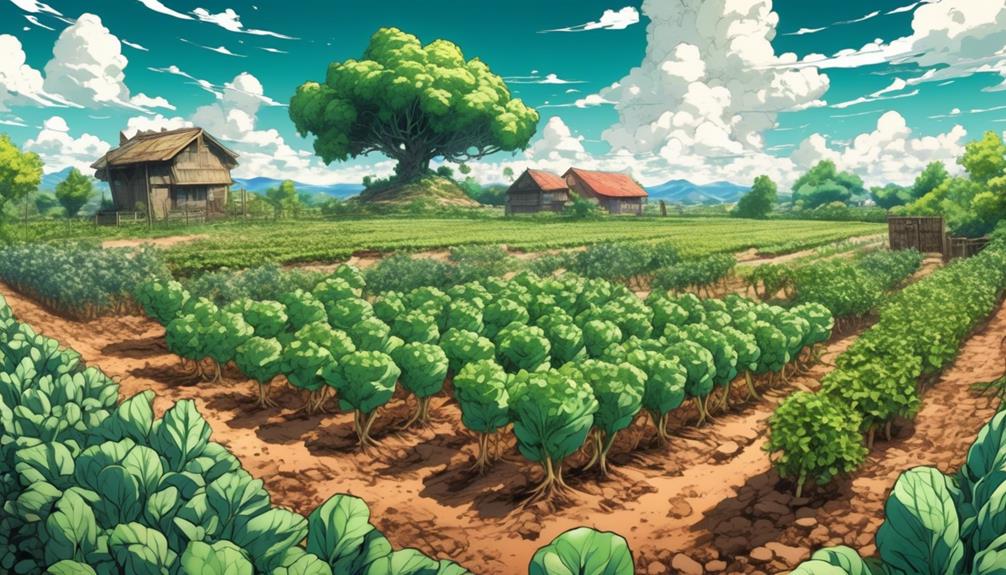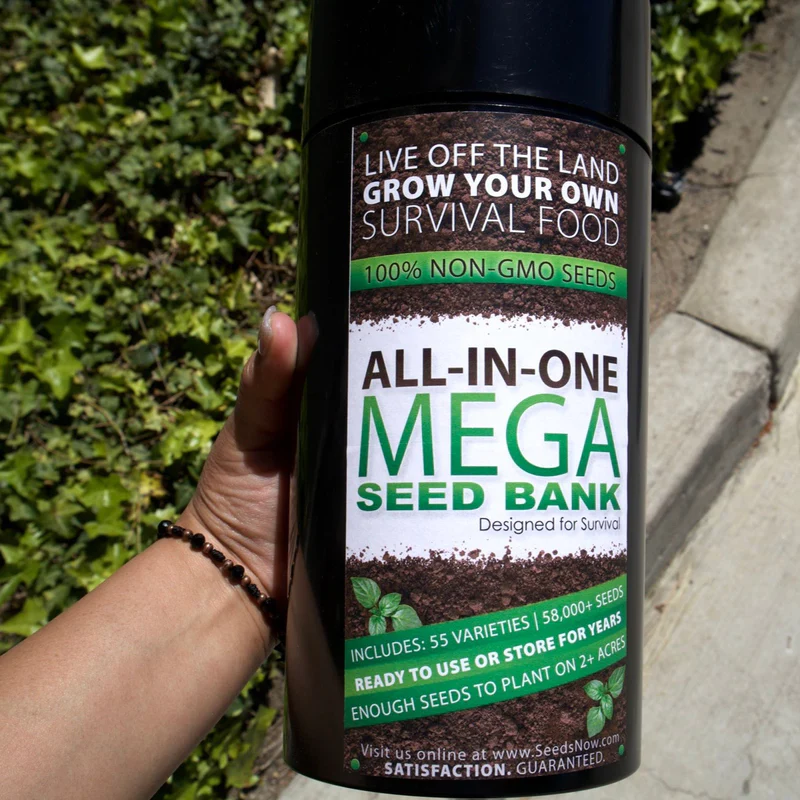In a world where the winds of uncertainty blow fiercely, it’s time to plant the seeds of resilience and self-sufficiency. Imagine a garden as your armor, shielding you from the hardships that may lie ahead.
But not just any garden – one that is filled with the ultimate survival crops, carefully selected to provide sustenance and strength in the face of adversity. From the robust amaranth that stands tall like an unwavering sentry, to the hearty Jerusalem artichoke that digs deep into the earth for nourishment, these crops hold the key to your survival.
But there’s more to this story, a world waiting to be unveiled – a world of nutrient-rich greens, bountiful fruits, and healing herbs.
So, step into the garden of resilience and discover the secrets that lie within.
Survival Crops Overview…
- High-calorie crops such as amaranth, Jerusalem artichoke, corn, and potatoes are excellent options for sustaining oneself during difficult times. They offer high yields, are easy to harvest and process, and provide significant calorie content per acre.
- Nut trees like hazelnuts are a viable choice due to their rapid calorie production, suitability for small areas, and nutritional value. They can provide a good source of nutrition for families.
- Leafy greens like kale, spinach, and Swiss chard are nutrient-dense and offer a variety of vitamins and minerals. They are relatively easy to grow and can be harvested multiple times throughout the growing season.
- Root vegetables like carrots, beets, and turnips are rich in vitamins and minerals and can be stored for extended periods. They are adaptable to various soil types and provide a moderate calorie yield per acre.
- Berries and fruits, such as strawberries, blueberries, raspberries, apples, pears, and peaches, are high in antioxidants and vitamins. They can be grown in small spaces and preserved through freezing or canning for year-round availability.
- Beans are beneficial for soil health and provide essential nutrients. They can be grown alongside grains and offer a good source of nutrition with diverse culinary uses.
- Squash offers both flesh and seed harvests, providing healthy carbohydrates and long-term storage options. Growing different varieties helps determine the best-tasting and most storable options.
- Tomatoes and peppers are versatile crops rich in vitamins and antioxidants. They can be preserved through canning, drying, or pickling and provide a moderate calorie yield per acre.
- Herbs and spices like basil, rosemary, turmeric, and others add flavor and nutritional value to meals. They can be grown in small pots or garden beds and offer various health benefits. Drying and storing herbs allows for year-round use and enhances food preservation.
- Medicinal plants like aloe vera, chamomile, and lavender have healing properties and can be grown indoors or outdoors depending on the climate.
High-Calorie Crops
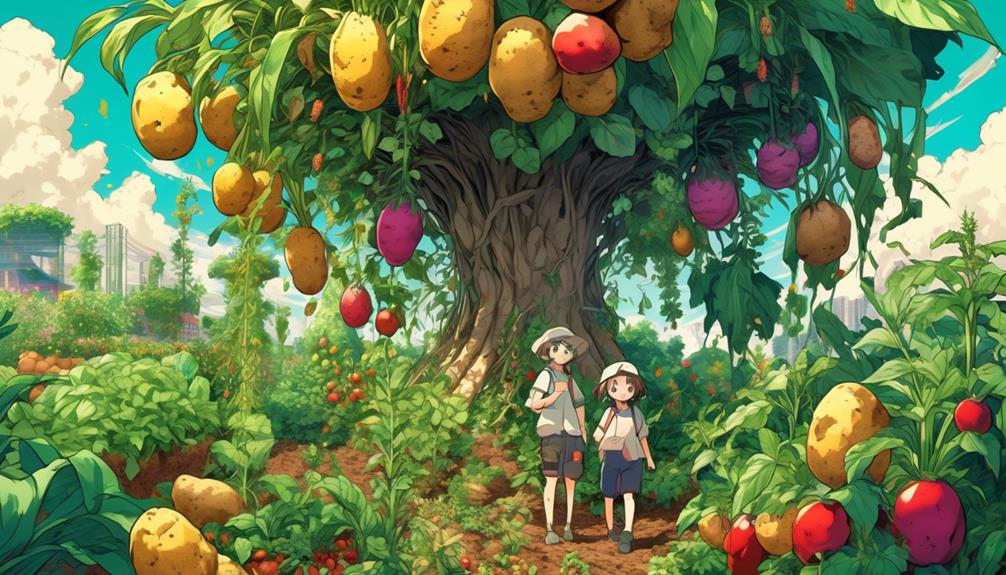
High-calorie crops are essential for survival in challenging circumstances, providing a reliable source of sustenance and energy. When it comes to maximizing calorie yield, it’s important to compare different high-calorie crops.
One such crop is amaranth, which has an average yield of 4.5 million calories per acre. It surpasses free-range chickens and cattle in terms of calorie yield and requires less nitrogen than corn.
Another high-calorie crop is the Jerusalem artichoke, with potential yields of 12 to 15 million calories per acre. It has historical evidence of reliance during times of war and famine and can be left in the ground during winter for harvesting as needed.
Corn is also a high-calorie crop, with one of the highest yields among all crops, providing up to 15 million calories per acre in high nitrogen soil.
Potatoes, particularly sweet potatoes, are highly nutritious and versatile, sustaining people during difficult times throughout history and offering up to 20 million calories per acre.
Nut Trees
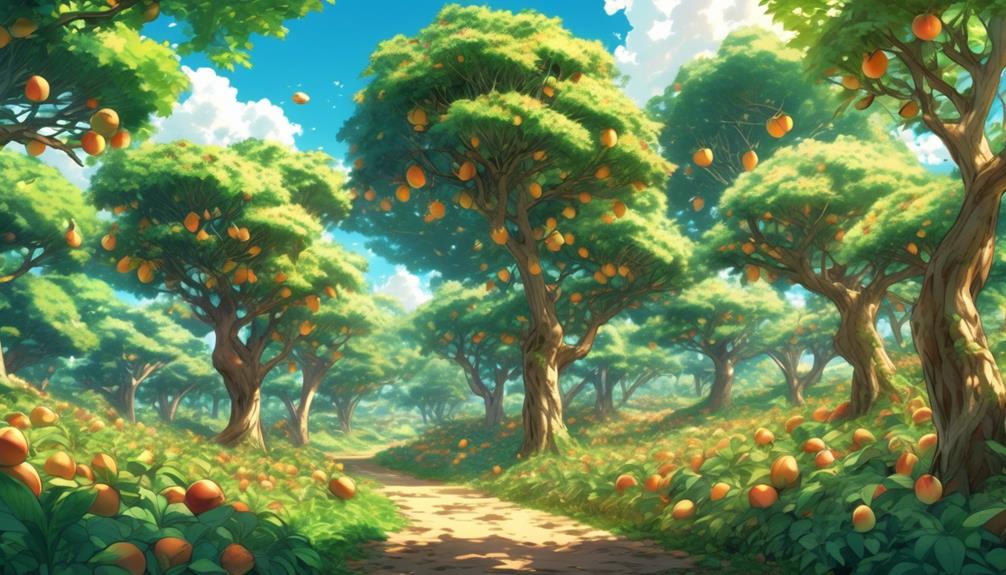
When considering the diverse range of crops that can provide sustenance in challenging circumstances, it’s important to explore the nutritional value and potential yield of nut trees.
Nut trees, such as hazelnut trees, offer a valuable source of nutrition and can be grown using specific growing techniques. Hazelnut trees can start producing crops in just 2-3 years and yield around 20-30 pounds per tree after 6-7 years. They provide rapid calories, with nearly 7.8 million calories per acre.
These trees are suitable for small areas and are nutritious, making them a good source of nutrition for families. By incorporating nut trees into your survival garden, you can ensure a sustainable and nourishing food source during hard times.
Leafy Greens
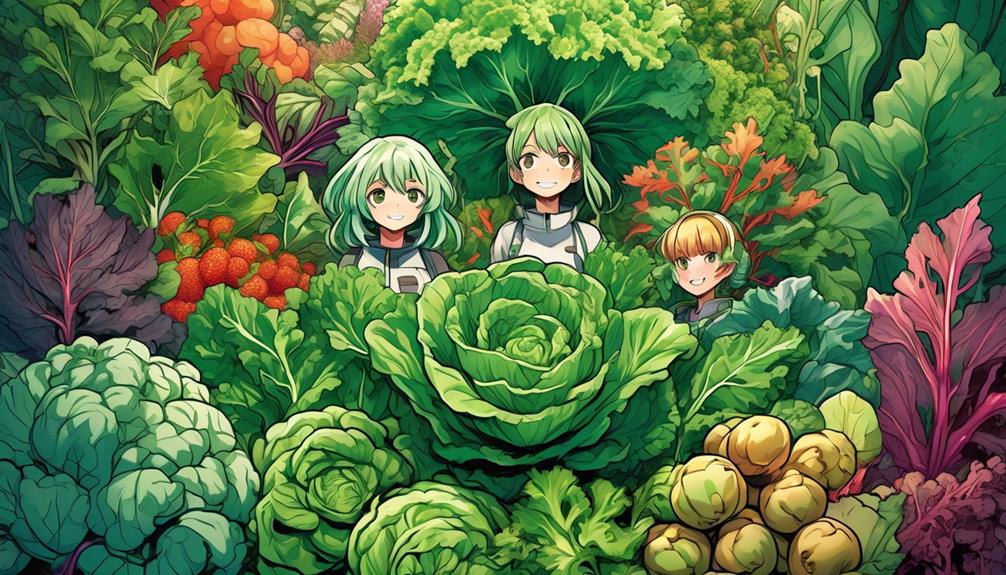
Leafy greens are an essential component of a survival garden, providing high levels of nutrition and offering a variety of vitamins and minerals to support your overall health and well-being. Kale, a member of the brassica family, is a nutrient powerhouse that’s easier to grow compared to other brassicas.
Spinach, another leafy green, is packed with nutrients and can be harvested multiple times throughout the growing season. Swiss chard is a nutritious leafy green that can also be harvested multiple times, rich in vitamins and minerals including iron and vitamin C.
To grow and harvest leafy greens efficiently, plant them in well-draining soil with plenty of organic matter. Ensure they receive adequate sunlight and water regularly. Harvest the outer leaves first, allowing the inner leaves to continue growing, and use them in salads, smoothies, or cooked dishes.
Leafy greens are an excellent addition to your survival garden, providing essential nutrients to keep you healthy during challenging times.
Root Vegetables
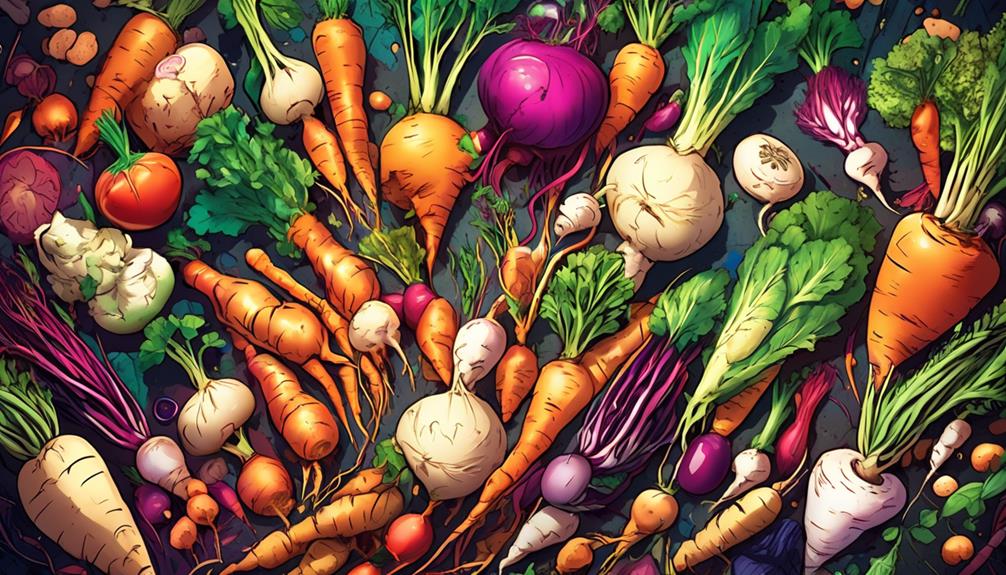
To continue diversifying your survival garden, let’s now explore the realm of root vegetables, which offer a multitude of nutritional benefits and can be a reliable source of sustenance during challenging times.
Here are three root vegetables that aren’t only easy to grow but also have effective storage methods:
Carrots:
These vibrant orange vegetables are rich in vitamins and minerals. They can be grown in various soil types and stored for extended periods. To grow carrots, sow the seeds directly into well-drained soil and keep them consistently moist. Harvest when they reach the desired size. To store carrots, remove the greens and place them in a cool, dark place with high humidity, such as a root cellar or refrigerator.
Beets:
Known for their ability to enhance blood flow and athletic performance, beets are a nutritious root vegetable. Some varieties have a short growing period, while others like mammoth mangle beets take around 100 days to grow. Harvest when they’re tender and store them in a cool, dark place until the next crop season.
Turnips:
While low in calories, turnips are high in vitamin C and potassium. They’re easy to grow and can be harvested when they reach the desired size. To store turnips, remove the greens and keep them in a cool, dark place with high humidity.
Berries and Fruits
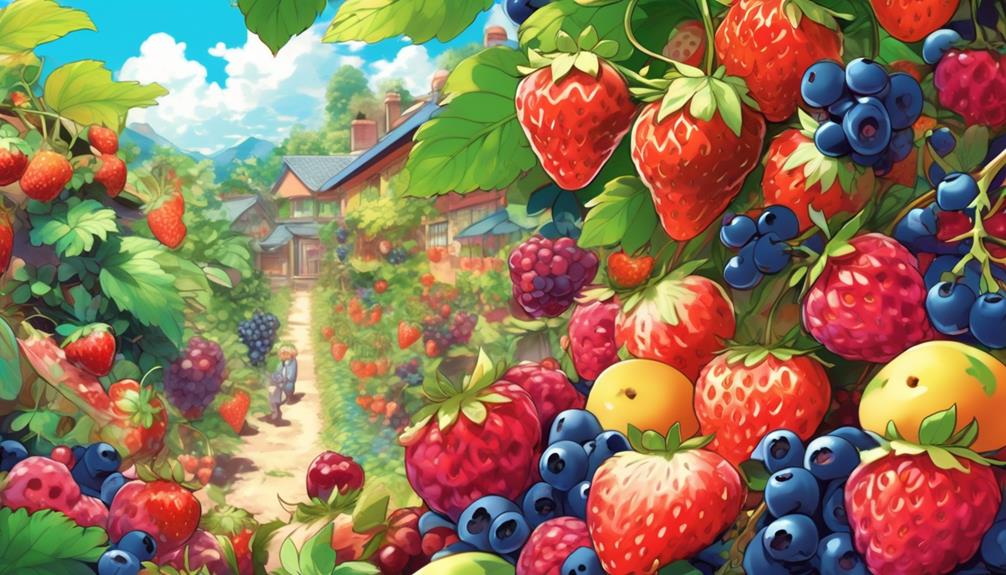
Berries and fruits are essential components of a diverse and nutritious survival garden, providing a sweet and flavorful source of vitamins, antioxidants, and other vital nutrients. These natural treats offer numerous health benefits, including boosting immune function, reducing inflammation, and improving heart health.
Growing berries and fruits in small spaces isn’t only feasible but also highly rewarding. Strawberries, blueberries, and raspberries, for example, can thrive in containers or hanging baskets, making them suitable for urban gardening. They can be preserved through freezing or canning, ensuring a year-round supply of these nutritious snacks.
Perennial fruits such as apples, pears, and peaches offer high calorie yields and can be dried or canned for long-term storage. By incorporating these delicious and nutritious berries and fruits into your survival garden, you can enhance your well-being and provide yourself with a reliable source of sustenance.
Beans

Beans are a highly beneficial crop for your survival garden, providing essential nutrients and the flexibility to be grown alongside grains or used in a variety of culinary dishes. Here are three key points to consider when growing beans in your survival garden:
Growing techniques:
Beans are relatively easy to grow and can be cultivated in both traditional garden beds and containers. They require well-drained soil and full sun exposure for optimal growth. Start by planting the seeds directly in the soil after the last frost, ensuring a spacing of about 4-6 inches between each plant. Regular watering is necessary to keep the soil moist but not waterlogged. As they grow, provide support such as trellises or stakes to help the plants climb and prevent them from sprawling on the ground.
Companion planting:
Beans are excellent companion plants for many other vegetables. They have a mutually beneficial relationship with plants like corn, as beans can fix nitrogen in the soil, which benefits nitrogen-hungry crops like corn. Additionally, planting beans alongside grains like rice or amaranth can maximize space utilization and create a diverse and balanced garden ecosystem.
Culinary versatility:
Beans offer a wide range of culinary possibilities. They can be cooked and added to soups, stews, and salads, or mashed into spreads like hummus. They can also be dried and stored for long-term use. With various bean varieties available, you can choose based on your culinary preferences and dietary needs, such as black beans, kidney beans, or chickpeas.
Squash
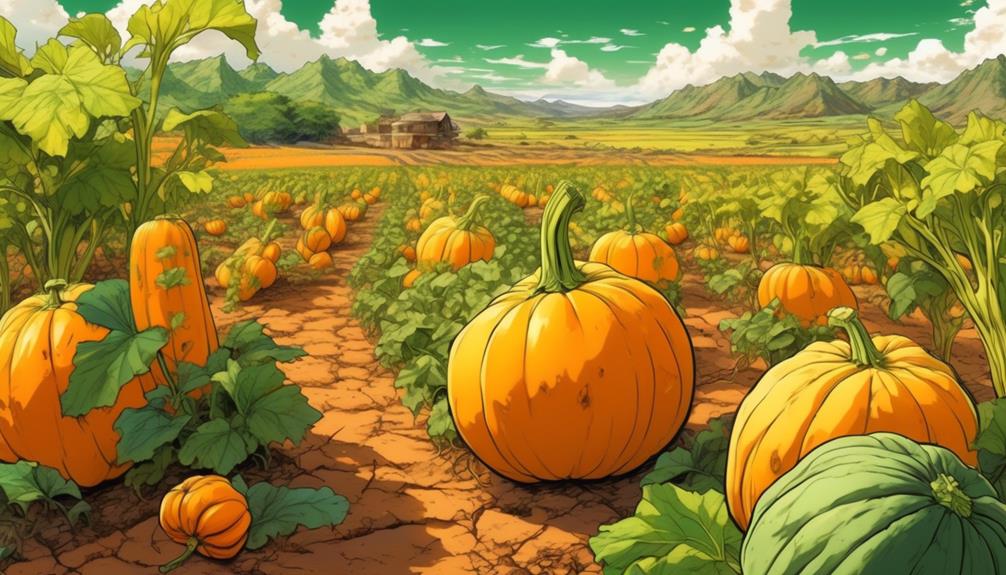
Squash, a versatile and nutritious crop, offers a dual harvest with its flesh providing healthy carbohydrates and its seeds offering additional benefits, making it an essential addition to your survival garden.
During difficult times, squash can serve as a staple food due to its long-term storage capabilities. When choosing squash varieties for long-term storage, look for those with thick, hard skins such as butternut, acorn, and Hubbard squash. These varieties can be stored for up to two years in a cool and dry place.
Squash isn’t only a reliable crop, but it also provides a wide range of culinary options, from roasting and baking to soups and stews. Including squash in your survival garden ensures a nutritious and satisfying food source, even during challenging years.
Tomatoes
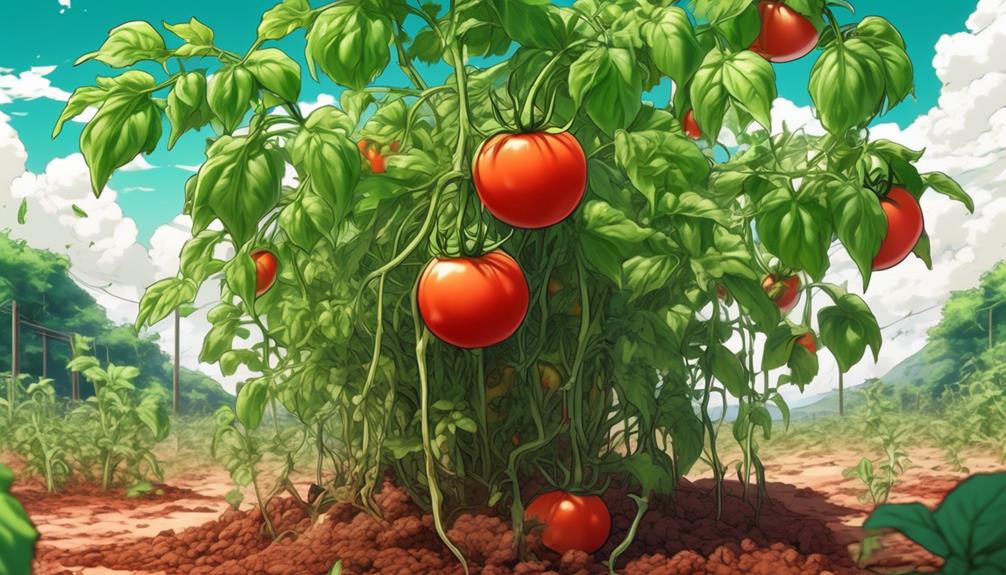
Tomatoes are a versatile and nutritious crop that can be easily grown in containers or gardens, providing a moderate calorie yield per acre and offering a range of culinary possibilities. Here are three best practices and tips for successfully growing tomatoes in urban environments:
- Choose the right variety: Select determinate varieties, which grow to a specific size and produce fruit all at once, making them ideal for smaller spaces. Consider cherry or patio varieties for container gardening. Indeterminate varieties, on the other hand, continue to grow and produce fruit throughout the season and require more space.
- Provide adequate sunlight and water: Tomatoes thrive in full sun, so ensure they receive at least six to eight hours of direct sunlight each day. Water them deeply, ensuring the soil is consistently moist but not waterlogged. Mulching around the plants can help retain moisture.
- Support and prune the plants: Use stakes, cages, or trellises to support the tomato plants as they grow. Prune the plants by removing suckers, which are the small branches that form in the leaf axils. This helps improve air circulation and encourages the plants to focus their energy on producing fruit.
Peppers
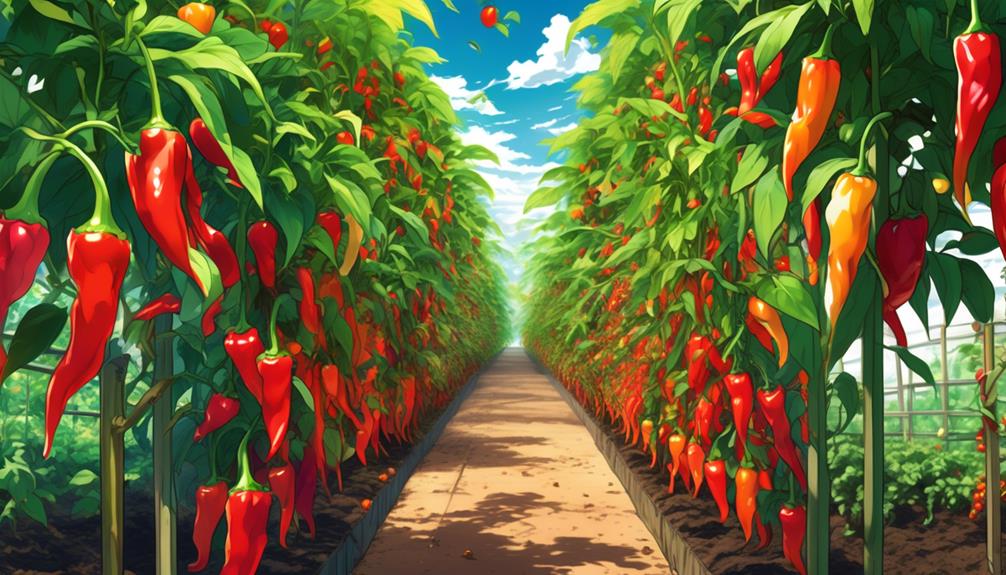
Peppers, another versatile crop, offer a range of culinary possibilities and are rich in vitamins, especially vitamin C, making them an excellent addition to any urban garden or container gardening setup.
Growing peppers in urban environments isn’t only feasible but also rewarding. Peppers thrive in well-drained soil and warm temperatures, making them suitable for container gardening on balconies or rooftops. Choose from various pepper varieties, such as bell peppers, jalapenos, or habaneros, depending on your desired level of heat and flavor.
To preserve peppers for long-term storage, drying or pickling is the way to go. Drying peppers can be done by stringing them up in a well-ventilated area or using a food dehydrator. Pickling peppers in vinegar brine enhances their shelf life and adds a tangy flavor.
With proper care and preservation, peppers can provide a moderate calorie yield per acre and add a spicy kick to your survival meals.
Herbs and Spices

When it comes to cultivating an abundant and flavorful survival garden, the subtopic of ‘Herbs and Spices’ is an essential component to consider. Growing herbs and spices for medicinal purposes can provide natural remedies for various ailments and enhance overall well-being. Additionally, exploring the culinary uses of herbs and spices in survival cooking can elevate the taste and nutritional value of meals, making them more enjoyable and satisfying.
Here are three key herbs and spices to include in your survival garden:
- Basil: Known for its aromatic flavor, basil isn’t only a versatile herb in cooking but also offers medicinal benefits such as anti-inflammatory properties and improved digestion. It can be easily grown in small pots or garden beds, making it accessible even in limited spaces.
- Rosemary: With its fragrant aroma and pine-like flavor, rosemary adds depth to dishes and can be used fresh or dried. It’s known to have antioxidant properties and may support memory and concentration. Growing rosemary in well-drained soil and providing adequate sunlight will ensure a healthy harvest.
- Turmeric: This vibrant yellow spice is prized for its anti-inflammatory properties and potential health benefits. It can be grown in pots or garden beds, preferably in a sunny location with well-drained soil. Harvest the rhizomes and grind them into a fine powder for use in cooking or as a natural remedy.
Starting a Survival Seed Bank
An integral part of growing a survival garden is to ensure you can continue to grow season after season. Starting a seed bank for your own survival garden is something that everyone should seriously consider.
Here are just some of the advantages of starting your own seed bank:
- Food Security: A survival seed bank ensures a continuous supply of fresh, nutritious food, even during times of crisis or food shortages. By having a diverse range of seeds, you can grow a variety of fruits, vegetables, and herbs that can sustain you and your family.
- Self-Sufficiency: By cultivating your own survival garden, you become less reliant on external sources for food. This promotes self-sufficiency and reduces dependency on grocery stores or food deliveries. It empowers you to take control of your own food production.
- Cost Savings: Growing your own food can significantly reduce your grocery bills. By establishing a survival seed bank, you can save money in the long run as you won’t have to continuously purchase seeds. Instead, you can collect and save seeds from your own crops for future planting.
- Adaptation to Local Conditions: By selecting and saving seeds from successful crops, you can gradually adapt the plants to your local growing conditions. Over time, the seeds will become better acclimated to your soil, climate, and specific micro-environment, increasing the likelihood of successful yields.
- Preservation of Heirloom and Rare Varieties: A seed bank allows you to preserve heirloom and rare plant varieties that may not be readily available in commercial markets. By growing and saving these seeds, you can help conserve biodiversity and maintain genetic diversity in food crops.
- Emergency Preparedness: Natural disasters, economic crises, or even personal emergencies can disrupt the regular food supply chain. A survival seed bank ensures that you have a backup plan in case of emergencies, providing you with a source of sustenance when other options may be limited.
- Educational Opportunities: Starting a survival seed bank can be a great educational experience for both children and adults. It allows you to learn about plant genetics, seed saving techniques, and sustainable agriculture practices, promoting a deeper understanding of the food production process.
- Stress Relief and Mental Well-being: Gardening has been proven to have therapeutic benefits, reducing stress and improving mental well-being. Tending to a survival garden and watching your plants grow can provide a sense of accomplishment, peace, and connection with nature.
Starting a survival seed bank for a survival garden offers a wide range of benefits, including food security, self-sufficiency, cost savings, adaptation to local conditions, preservation of heirloom varieties, emergency preparedness, educational opportunities, and improved mental well-being. It is a valuable investment in ensuring a sustainable and resilient food supply for yourself and your family.
Read More Here: How to Start a Seed Bank & Why Every Gardener Needs One
Or… if you’re looking to jump start your own survival garden seed bank, you can also consider buying a ready made seed bank from a reputable seed supplier.
The Mega Seed Bank is one of the most comprehensive Seed Banks available. Packaged for survival & long-term storage. A great investment for when seeds no longer become available and/or if there are severe shortages in supply.
What’s included?
- 55 different varieties of seeds – over 58,000+ seeds in total – All tested to ensure extremely high germination rate. 100% GMO-FREE, Heirloom/Non-Hybrid, and Open-Pollinated, which means you will be able to save and replant the seeds after a successful harvest.
- All items come individually packaged inside a Large Seed Storage Vault – a heavy-duty vacuum sealing storage container. Provides superior moisture barrier + Pest, insect, and rodent resistant. It’s also Freezer safe.
The Mega Seed Bank is so robust & well packaged you could even bury it in the garden for safe keeping. The seeds will remain viable for many years to come and you’ll always have a safe supply of seeds for any future emergencies. If you can afford it, buying a seed bank is a great way to get started quickly.
Ultimate Survival Crops
In the face of uncertainty, knowledge and preparation are essential for survival. By cultivating a diverse range of high-calorie crops, nutrient-rich options, and medicinal plants, you can create a sustainable food source that can withstand challenging circumstances.
Whether you have limited space or a small garden, there are crops suitable for various environments that can be preserved for long-term storage. Empower yourself with the knowledge to thrive in hard times and ensure your survival.
Let’s embark on this journey together and discover the ultimate survival crops.
